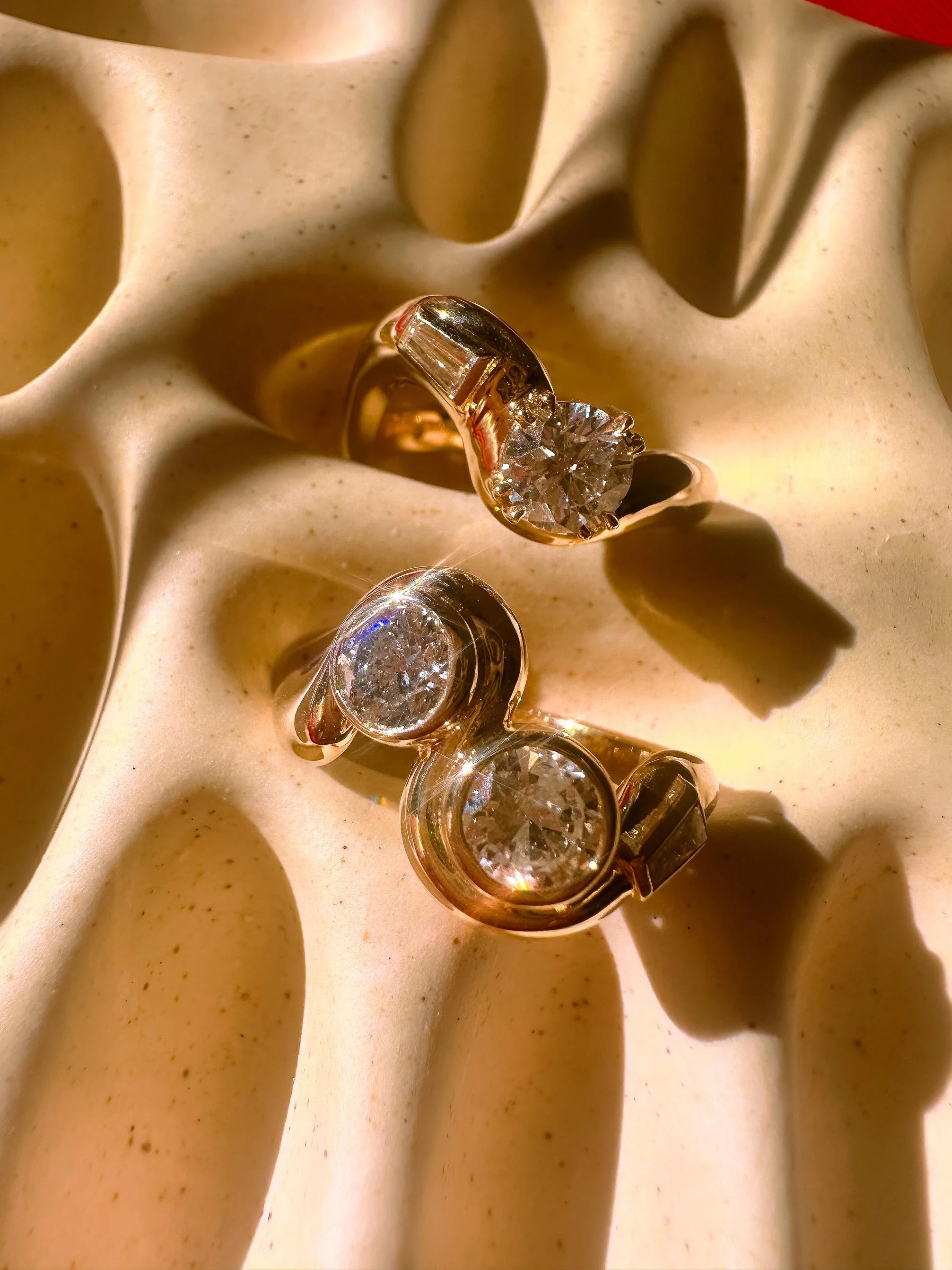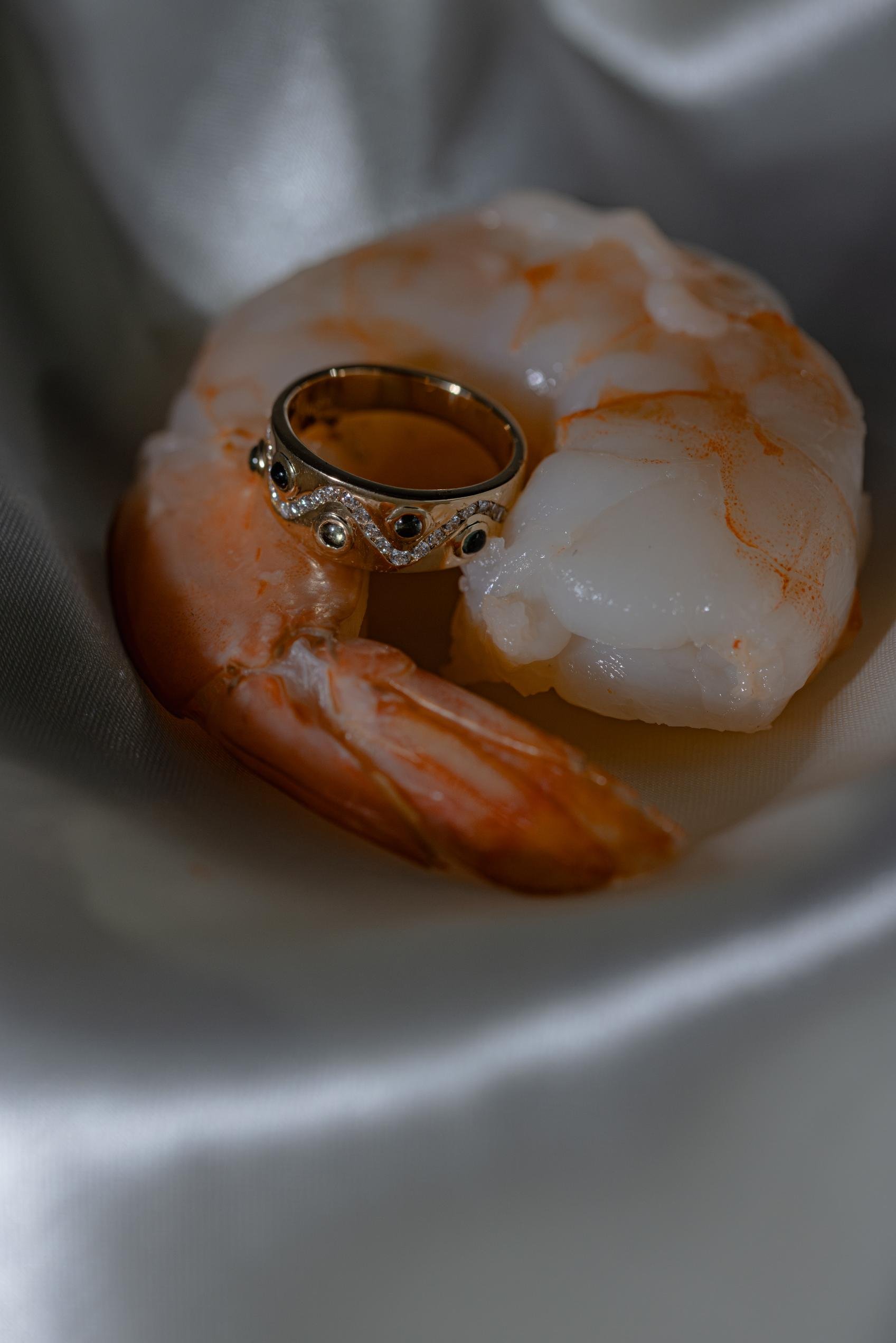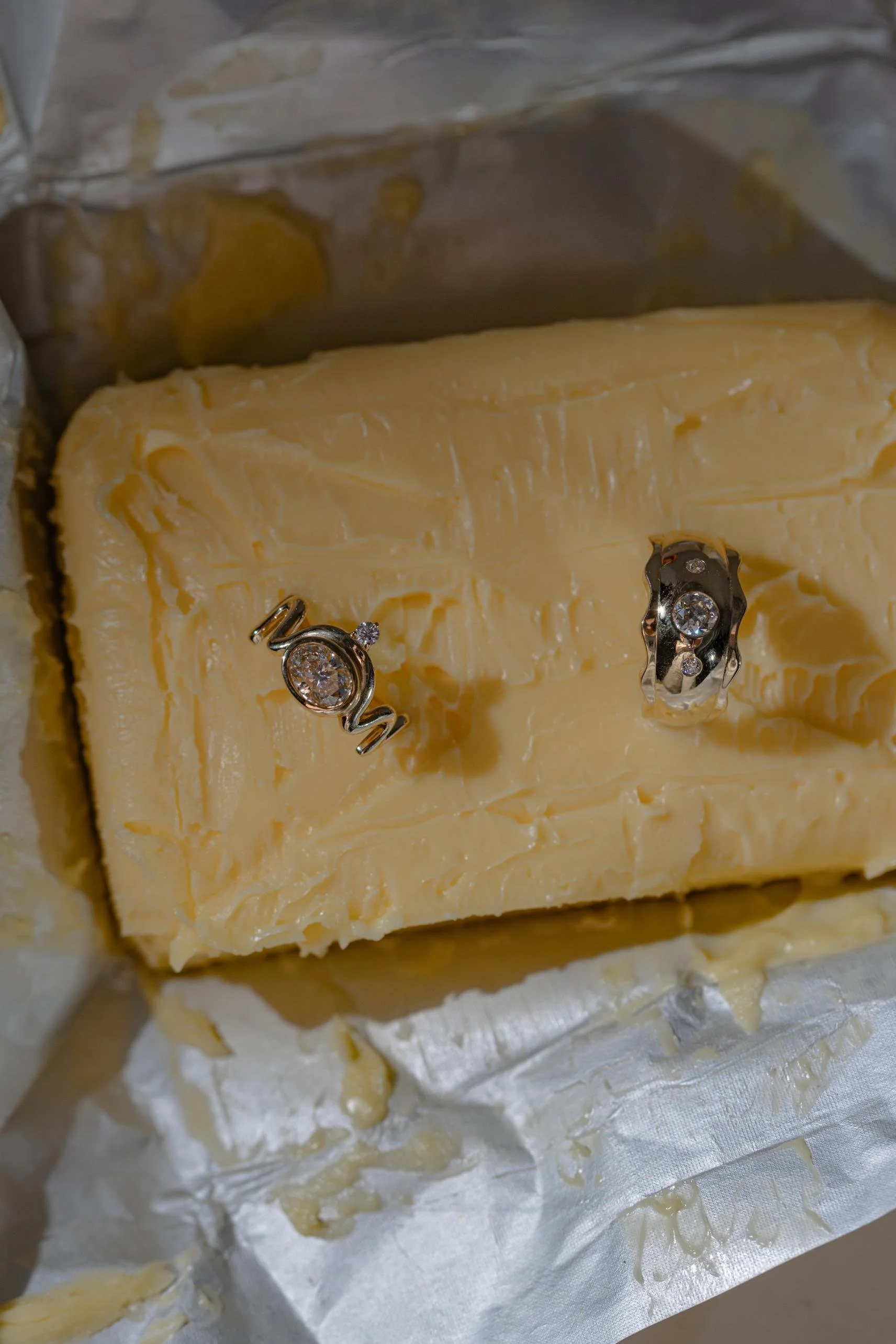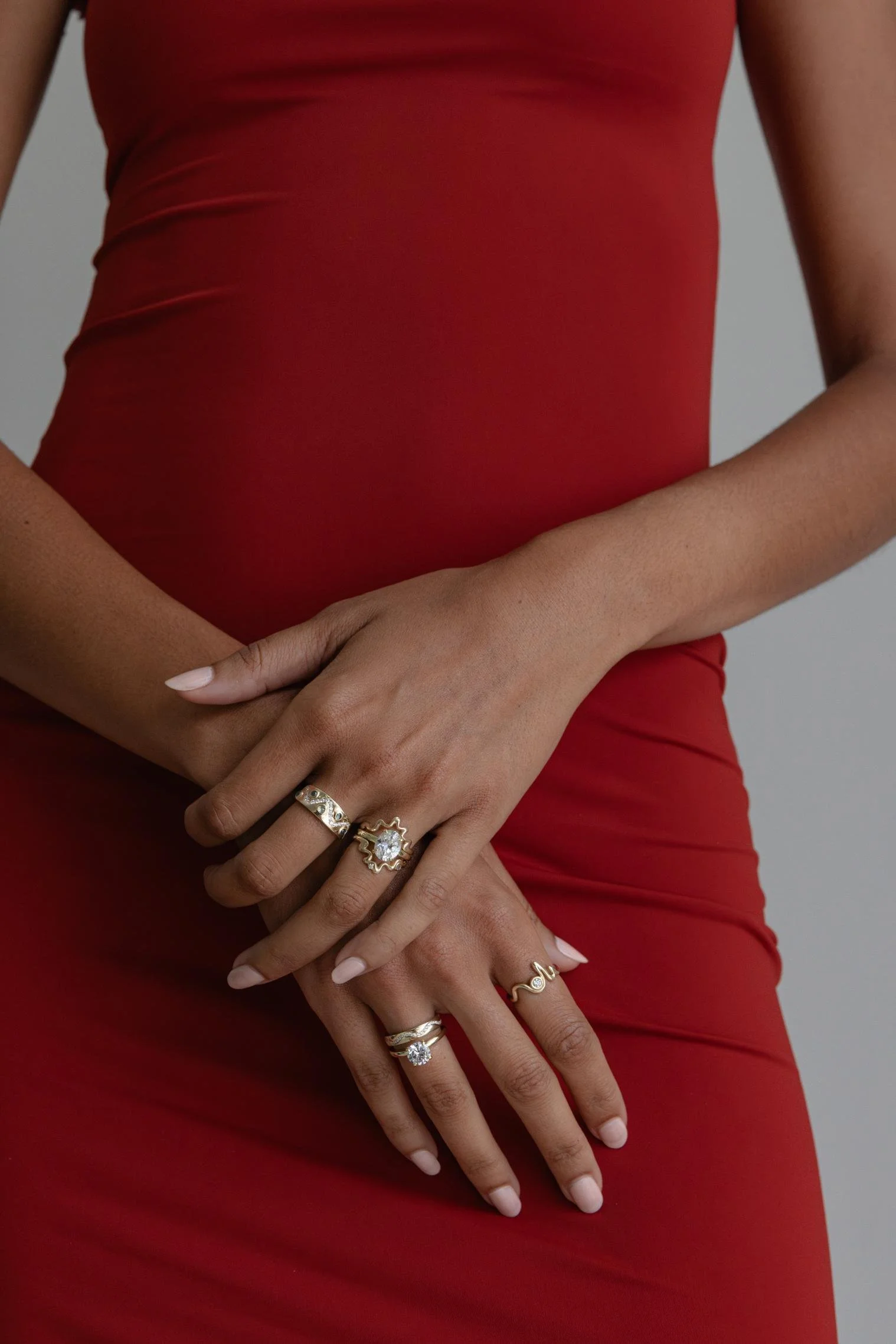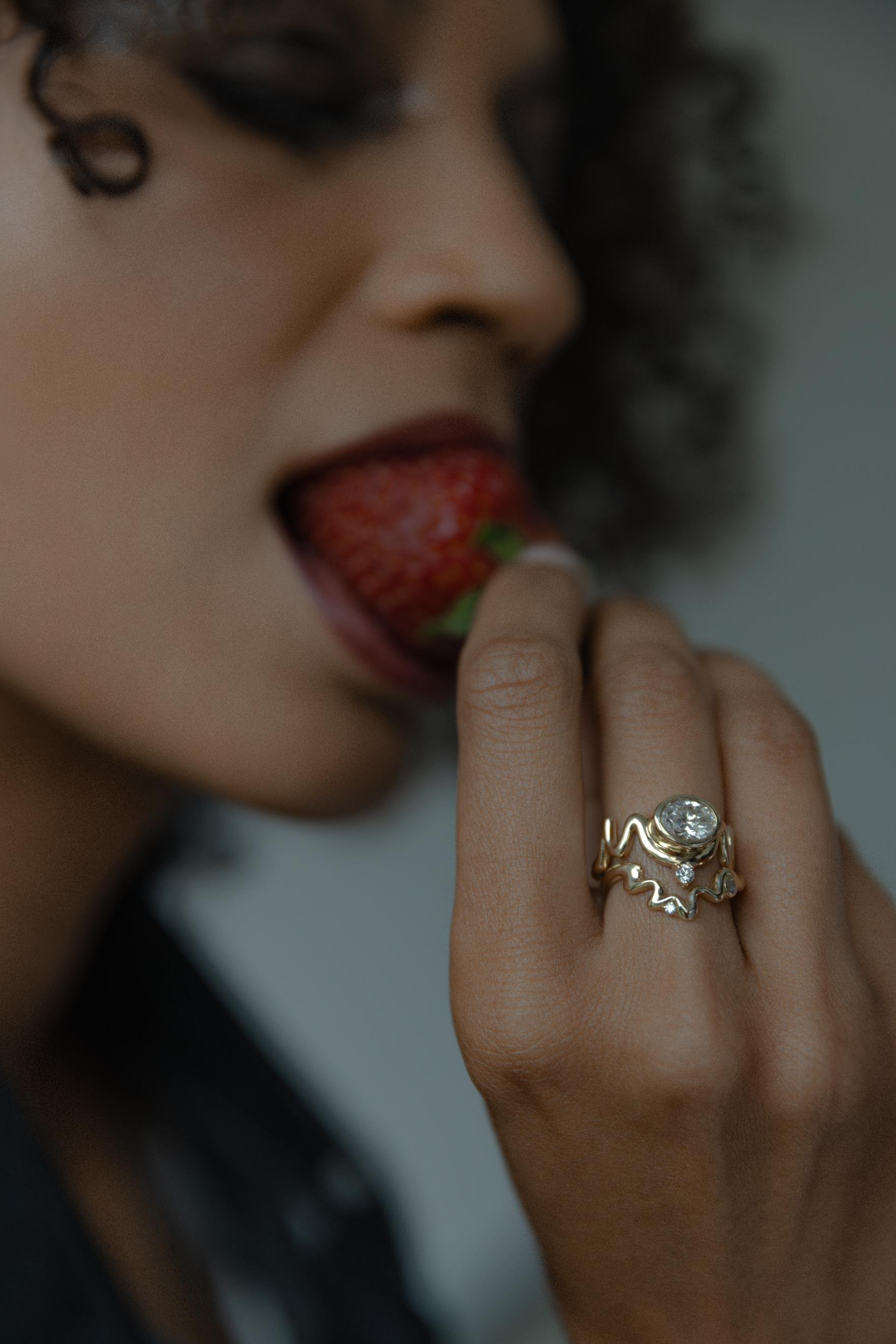Engagement Rings & Ethical Jewelry: Insight from Crevette Design Studio
Written by Lindsey Chronert
Some of you have heard stories of my sweet grandma and how we celebrated her 100th birthday. She's been a role model throughout my entire life. When we were kids, she sewed sleeping bags and took us camping in Yosemite. She taught me how to play cards and ride a bicycle. And during the pandemic, she took virtual kick-boxing classes and learned to play mahjong. She lives with my aunt now, and despite reading the paper and playing sudoku every morning, she's starting to slow down. She'll be 102 in November.
Just a few weeks ago, she asked me to come over to look at her jewelry. She still wears a simple band on her wedding ring finger, but she hasn't worn her wedding rings in quite some time. She wanted to know if I'd like to have them. There were a lot of feelings that came up, but mainly I'm just so grateful to have spent my life so close to her. I'd cherish a used tea bag if she gave it to me.
I've been thinking a lot about life in 1943 when she married my grandpa, how they built a home together, and everything she experienced in a century of life. They were married for 69 years. She's had this tiny ring for over 80 years. It's just amazing that it was never lost. Everything they were and everything they symbolized is held in this tiny piece of sparkly jewelry. Inside the stones she wore every single day is a lifetime of love, grief, fear, surprise, rage, and joy. How do I honor these stories and celebrate these stones?
The timing is wild. For years I've wanted to talk about engagement rings in the MIHO Journal. Just recently, I emailed Victoria Schulte and Charlotte Zappulla at Crevette. I knew nothing about wedding rings. My only knowledge about diamonds comes from the 2006 film where Leonardo Dicaprio played a diamond smuggler in the Sierra Leone Civil War in the 90's. I asked if they could help educate me and our readers on the ethical sourcing of diamonds and other gemstones.
But if you're like me and don't have much knowledge about diamonds, gemstones or rings, you need to read this article. Even if you consider yourself an expert, these women are doing incredible work that you need to see.
Join us for an exclusive interview with Charlotte Zappulla and Victoria Schulte, the masterminds behind Crevette Design Studio, as they share their insights on selecting the perfect engagement ring, navigating ethical sourcing practices, and the artistry behind each exquisite piece.
With over thirteen years of combined experience in the fine jewelry industry, the duo founded Crevette. Crevette (pronounced “krah-vet”) is a French term of endearment meaning “little one,” or “shrimp” in English. Their unique approach to jewelry design is infused with unexpected charm and authenticity, rooted in artistic exploration and timeless elegance.
Crevette means little one or shrimp in French.
Victoria Zappulla & Charlotte Schulte, Owners
What essential factors should individuals consider when selecting an engagement ring?
First of all, consider your budget. This is a huge one in determining what you'll be willing to spend and where your efforts in your search should be. The second factor is material: are you wanting a diamond or gemstone? If diamond, what considerations are you looking for—do you want natural or lab-grown, antique or modern, specific certifications, quality, etc?
If you're wanting to go the colored gemstone route, we would highly encourage a sapphire or ruby, as they are a harder material and durable enough for the everyday wear of an engagement ring. We also love spinel!
Finally, ask yourself what do you want aesthetically in a ring? Do you like more sleek and modern, chunky and whimsical, organic and unique? There are so many amazing designers out there—you can truly find anything outside of the ordinary cookie-cutter ring, if that's not what you’re looking for.
Ethical considerations have become increasingly important to consumers. How does Crevette address ethical sourcing and sustainable practices when selecting gemstones and crafting engagement rings?
Educating clients about the realities of the industry is so important to us—both ethically and economically. There are a lot of misconceptions out there when it comes to diamonds! But ultimately, we feel that as long as we give a client all the information we can up front, they will make the best decision for themselves. We’re just happy to be a part of their love story!
One way we love to address ethical and sustainability concerns is by sourcing antique and reclaimed diamonds and gemstones. These are not only a “greener” alternative due to the recycled component (they’ve been around for a century many times!), they are also all hand-cut which makes them incredibly unique and special.
We also work closely with a few selected gemstone dealers who have either sourced rough themselves, or have a way to grade the fair trade level of each stone, from the mining to cutting stages. Luckily, this has become a much more buzzworthy topic within the industry, pushing a lot of vendors to provide more information about their stones. We’ve even seen a few vendors who offer a blockchain of sorts for larger stones, where you have photos of the rough, to preformed cut, to final polish.
Reclaimed or vintage rings are gaining popularity as a sustainable and ethical choice. Could you elaborate on what these rings are or why you enjoy working with them?
Reclaimed jewelry or stones are pieces that have been pre-owned (also called estate jewelry), or the stones were in another piece of jewelry and taken out for use. Vintage jewelry is typically classified as anything between 50-100 years old, meaning anything from the 1970s or older, while antique jewelry is classified as 100 years old or older. We find the craftsmanship of these pieces and stones to be incredible, especially considering the technology they had at the time. You can really tell that so much love and care went into each piece!
Some couples may want to incorporate family heirloom stones into the engagement ring. What are the considerations for using heirloom gemstones in a new design, and how can this process be personalized?
The first consideration is whether the gemstone is durable enough to withstand being unset and reset. Sometimes after years or decades of wear, certain stones can bear the brunt of hard knocks or dings and scratch, chip or break. We always want to make sure that the stones are not being put at further risk by being set again (which can potentially damage a fragile stone).
The second consideration is how the stone will fit into the overall vision you have for the piece. Oftentimes we have clients who have a picture in their mind of their ideal piece, but their heirlooms are much larger or smaller, so they have to mentally pivot a bit. It’s so special to include family heirlooms into a design; it definitely feels like carrying a piece of the past into the future in a personalized and unique way.
Some individuals might prefer alternative gemstones over traditional diamonds. What are some popular ethical gemstone options, and how do they compare in terms of durability and sparkle?
I love sapphire as an alternative to diamond. It’s a 9 on the Mohs hardness scale, so it can withstand daily wear over the years, and the colors you can get from sapphire are incredible. If you’re looking for something that you can be sure is ethical, Montana sapphires are a great option, as they’re mined in the United States and thus have to abide by the labor and environmental laws in the country.
Lab-grown diamonds are becoming more prevalent in the market. Can you explain the difference between natural diamonds and lab-grown ones, and what are the implications of choosing one over the other?
Whew, this is a complex question! Chemically, natural diamonds and lab diamonds are the same composition– they’re both composed entirely of carbon (with trace elements that create some inclusions or body color). The difference is that natural diamonds are created deep beneath the earth’s surface for millions of years, and lab-grown diamonds are created under similar conditions in a MUCH shorter period of time. Because of the advancements in technology over the last decade (and specifically the last five years), the industry has seen a massive increase in the supply of lab diamonds, and the demand has also increased, as the price points tend to be significantly lower than that of natural diamonds.
However, with a massive increase in supply, the price has fallen even more. Although natural diamonds are not rare by any means, because they are a natural resource, there will always be a rarity aspect to them which stabilizes the market in a certain way. Their value is a little more predictable, as we have more history to reference. Because lab diamonds are still so new, we don’t have as much historical data on the economics and their ability to hold value, so it can be a bit precarious when you’re investing a large sum of money into that. But again, every large purchase has a risk associated with it (you might buy a house in a future earthquake or fire zone, for example– you really never know what is going to happen!). The industry simply knows less about the risks and returns with lab-grown diamonds. But if you are planning on keeping it forever (like many people who buy engagement rings), then you really can’t tell the difference and it’s a great way to save some money to put towards some of the more expensive aspects of life!
In your experience, what are some misconceptions or myths surrounding ethical considerations in the jewelry industry, and how can consumers be better informed?
That all natural diamonds are blood diamonds (and this is based on the hit 2006 feature film starring Leonardo DiCaprio haha). There certainly are aspects of the industry that need to be improved, and holding companies accountable to more transparent, sustainable, and ethical practices is a great way to start. Consumers can ask questions of their jewelers about the stones or materials they are using and will hopefully get a transparent answer.
What certifications or standards should consumers look for when purchasing an engagement ring?
If you’re looking for a diamond, GIA certification is pretty much the gold standard for natural and lab-grown diamonds alike. It’s worth noting, however, that many antique or vintage stones won’t have these certificates, so that’s when you have to find a trustworthy source or have a bit of knowledge on the stone.
As for gemstones, unless there is a specific claim, such as unheated sapphire, or no-oil emerald, a vast majority of gemstones won’t come with a certification. With any claims around sustainability or ethicality, we would recommend asking for some sort of proof or transparency around that. A lot of larger jewelry companies love to greenwash their products and have very little to back it up with (although this is not exclusive to the jewelry industry).
What advice do you have for preserving and caring for a ring to maintain its beauty and longevity throughout generations?
Make sure to remove your jewelry before working out, swimming, cleaning or doing anything that will put your hands at risk of knocking or gripping hard surfaces. Avoid wearing fine jewelry while working with harsh chemicals (looking at you, hair stylists!) because the chemicals can corrode the alloy metals in the gold and cause it to become weakened, ultimately leading to breaking or other damage.
Take your jewelry to a trusted jeweler for regular check-ups to make sure the stones are tight in their settings so you don’t lose anything! If you have a stone that is wiggly in its setting, stop wearing it immediately and take it to the jeweler because that situation can escalate quickly to a lost stone. And it never hurts to have your jewelry professionally cleaned at least once every year!
Where do you find inspiration?
Our designer, Charlotte, finds inspiration in nature, architecture, other media of art, and really any sort of small detail, color scheme, shape, or form that she finds visually interesting or thinks would translate into jewelry materials well.
Victoria, although not a jewelry designer, handles many creative aspects of the brand and its creative direction. She finds inspiration by spending time by water and watching the sky, by reading, by perusing magazines and Pinterest, by looking for juxtapositions throughout the world, and through movement of all forms. Our inaugural collection, FLOW, was inspired by movement, and specifically the emotional movement through life as you go through changes and new phases.
What other designers do you love?
Polly Wales’s work is exceptional for both of us; Charlotte would love to own one of her pieces one day. Her use of color is inspirational. She also loves Anthony Lent; he creates such detailed and whimsical designs, and his design process is amazing.
Find more on Instagram @crevettedesignstudio or www.crevettedesignstudio.com


